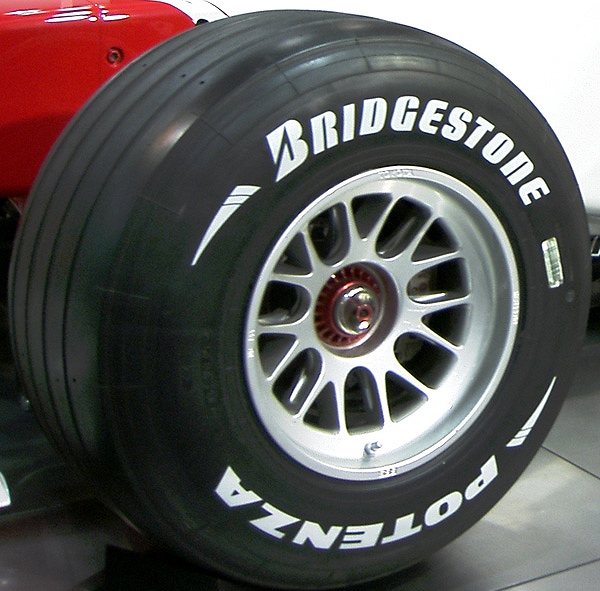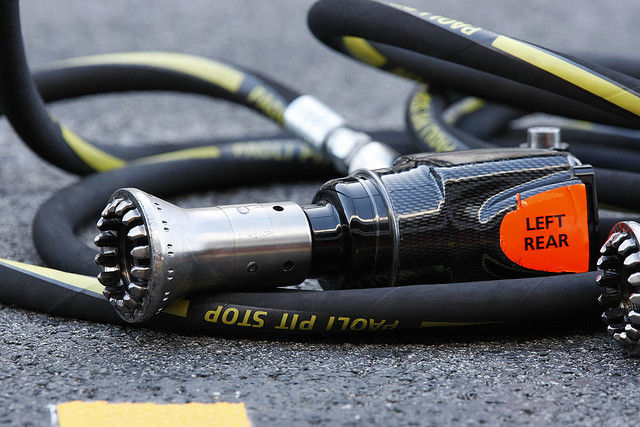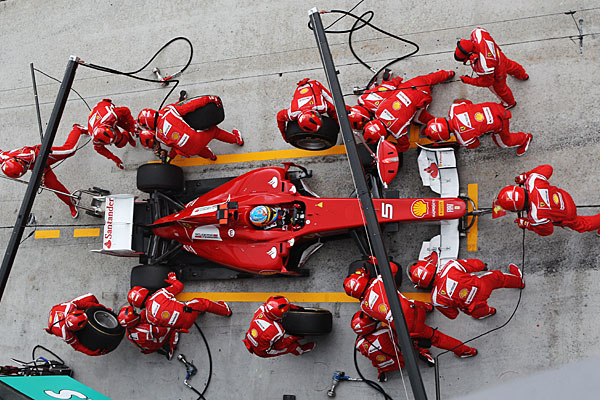Pit Stop
by Andrew Boyd
Today, a sight to behold. The University of Houston's College of Engineering presents this series about the machines that make our civilization run, and the people whose ingenuity created them.
Magic shows are fun because we get to experience the impossible. Still, we know there's trickery afoot. But what about those times when the magic isn't magic? When we witness something that's seemingly impossible but proves all too real?
Such is the case in, of all places, the Formula One race car pit, where pit stops now take two seconds. Start the clock. [2 second delay] Stop. That's the time it takes to raise a car, change four tires, and send it on its way.

An F1 Pit Sign (Bert Van Dijk/Flickr)
The role of the pit has changed drastically over the years. For much of racing it was assumed cars would stop only in the event of problems. Scheduled tire changes or fuel stops weren't part of the equation. This orthodoxy was challenged in 1982 when an inventive race team from the U.K. focused on two important facts. First, softer tires stuck to the track better during turns than their harder cousins, though they wore out more quickly. Second, less gas in the tank translated into a lighter, and therefore faster, car. Calculations showed that time spent changing tires and refilling the tank was more than offset by the improved performance of the car on the track.
It was great idea that quickly caught on, making pit stops — and their efficient execution — an integral part of racing. When refueling's in play, it tends to be the bottleneck during pit stops. As long as tire changes were faster than refueling there wasn't much impetus to speed them up. That changed in 2010 when Formula One racing adopted a no refueling policy. The stage was set for lightening fast tire changes.
So how do you complete a tire change in two seconds? It starts with the lug nuts, or rather, nut. It's big, and easily gripped by a self positioning pneumatic wheel gun that loosens and tightens it. Every aspect of the design's been rethought with the single-minded goal of easy on, easy off. This isn't your father's Oldsmobile.

A Bridgestone Potenza Formula One Tire (Wikimedia)

A Renault Wheel Gun (Alex Comerford/Flickr)
Then there's the team. Each wheel receives the attention of three people. One removes the old tire, one positions the new, and a third operates the gun. They're joined by two jack men, one front, one rear, who raise and lower the car. Together they dance their own highly abbreviated version of the Minute Waltz.

Ferrari pitstop during the Malaysia Formula 1, May 8-10, 2011 (Royal Dutch Shell/Flickr)
It's not a job for just anyone. Pit crews train like athletes in specialized facilities. Their moves are choreographed: how to grasp a tire; where and when to move their feet. Teams that take over 3 seconds aren't cutting it. But when a pit crew's clicking, it's a sight to behold; a sight that leaves you asking, "did I really see that?" But not to worry — you did. That is, of course, unless you blinked your eyes...
[audio: Chopin's Minute Waltz]
I'm Andy Boyd at the University of Houston, where we're interested in the way inventive minds work.
(Theme music)
Notes and references:
A scheduled pit stop was used in the 1957 German Grand Prix by winner Juan Manuel Fangio, but industry acceptance is typically accorded to the efforts of the 1982 Brabham team.
Refueling was banned for the ten year stretch from 1984 to 1993, though this is not explicitly mentioned in the essay to avoid on-air confusion. During this period efforts focused on improving the speed of tire changes, just as they did after 2010, but they didn't approach the 2 second mark. See: Gray, W. Tech Talk: Can F1 Pit Stops Get Even Quicker? Eurosport, April 9, 2013.
This episode first aired on May 29, 2014.